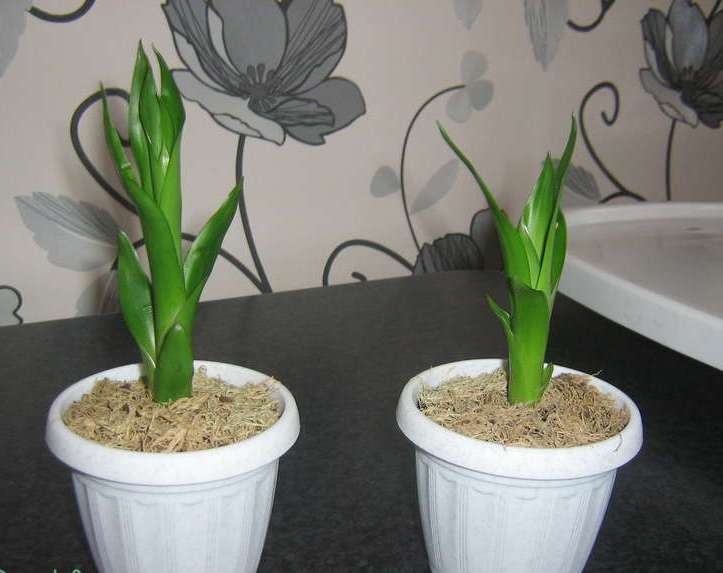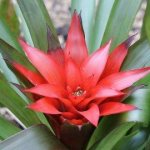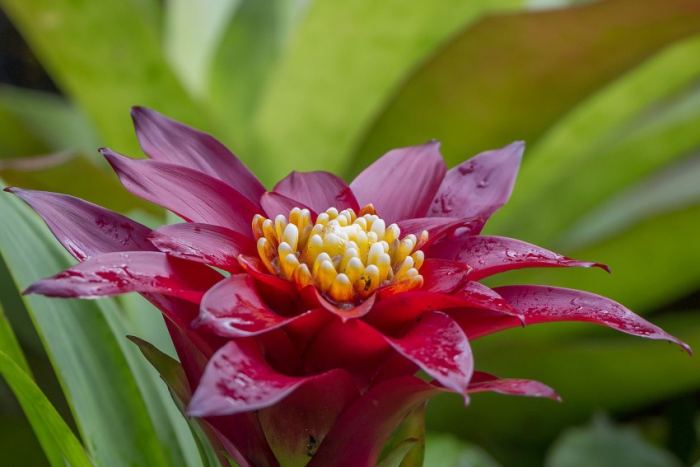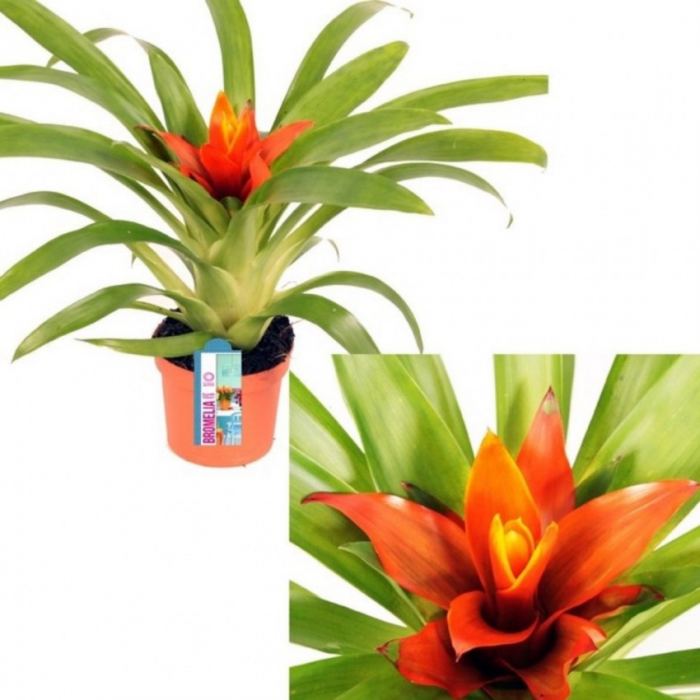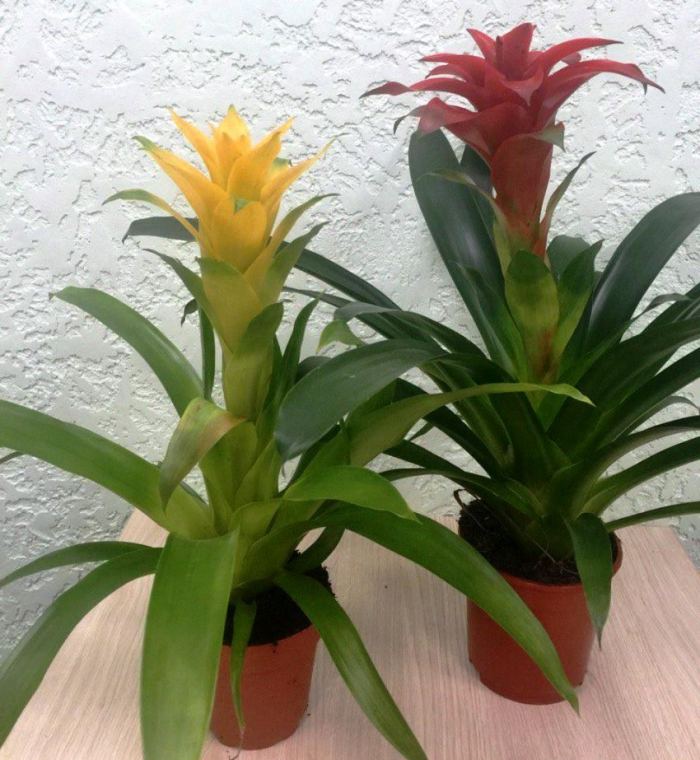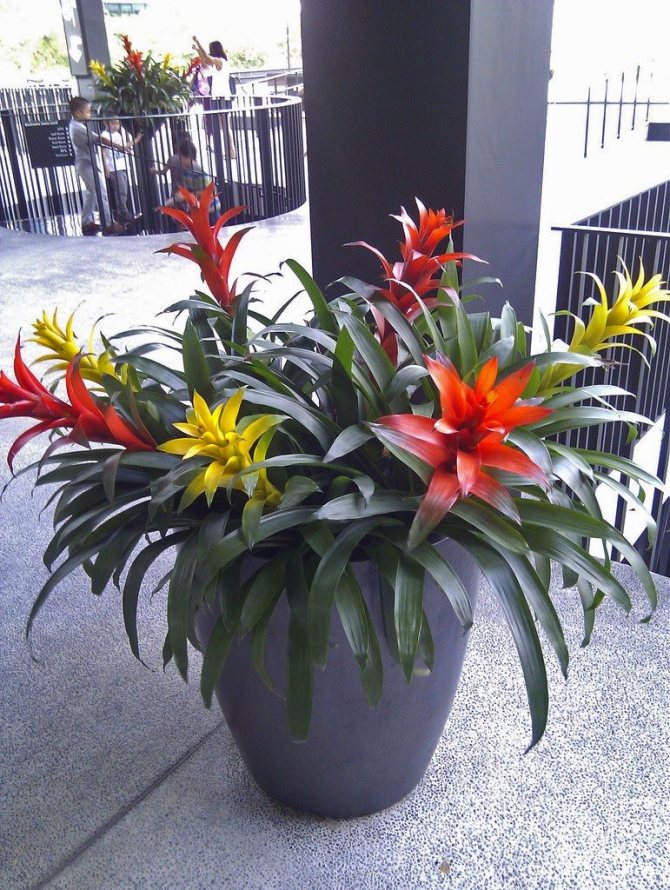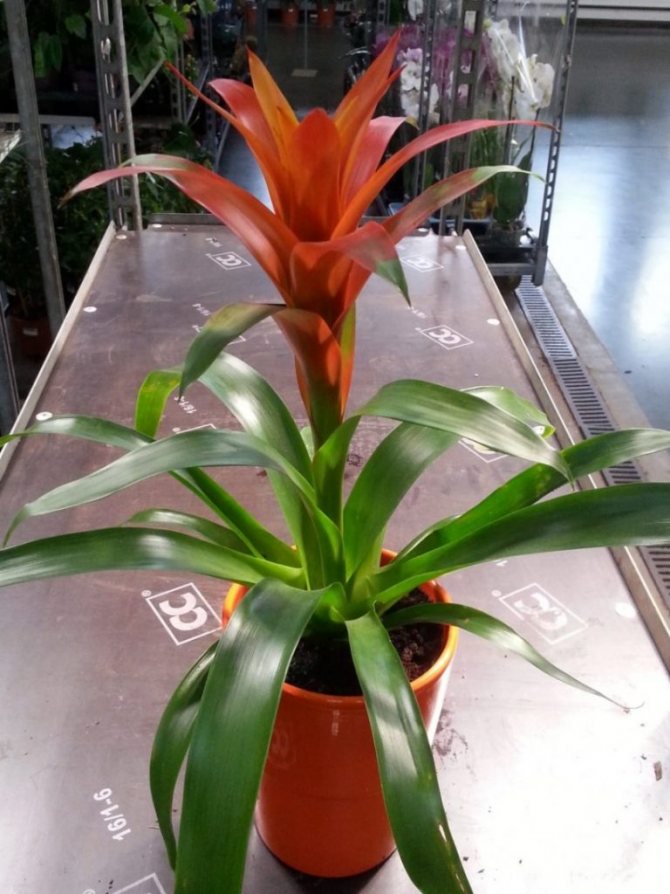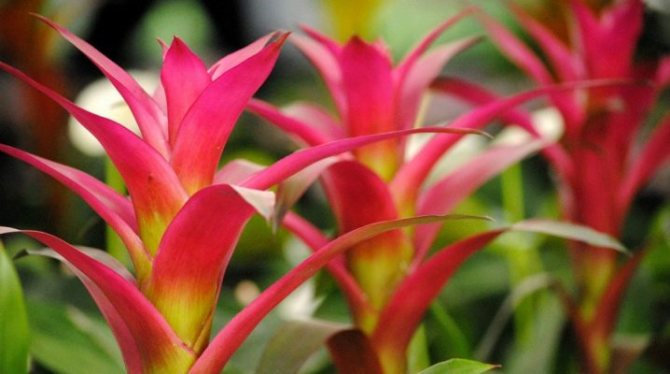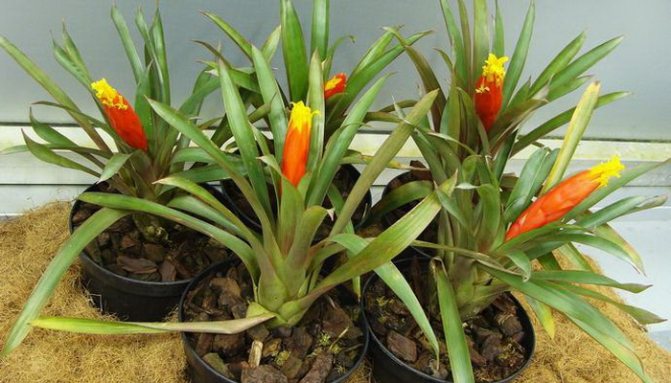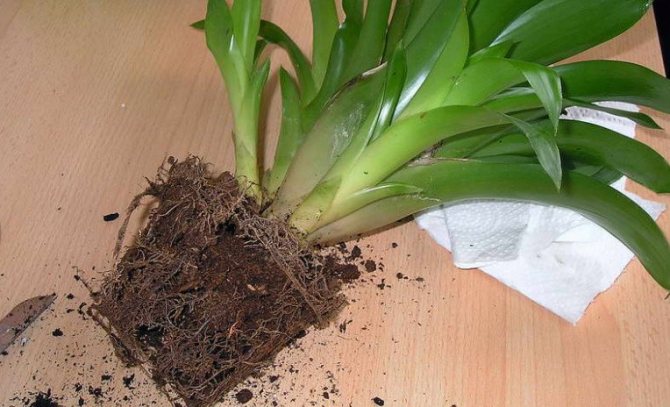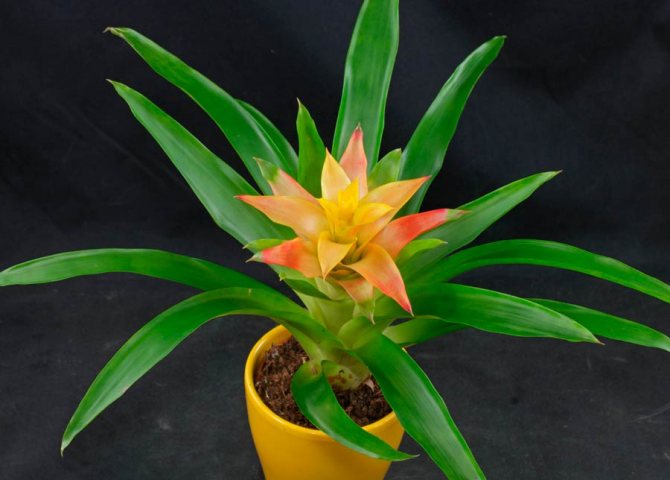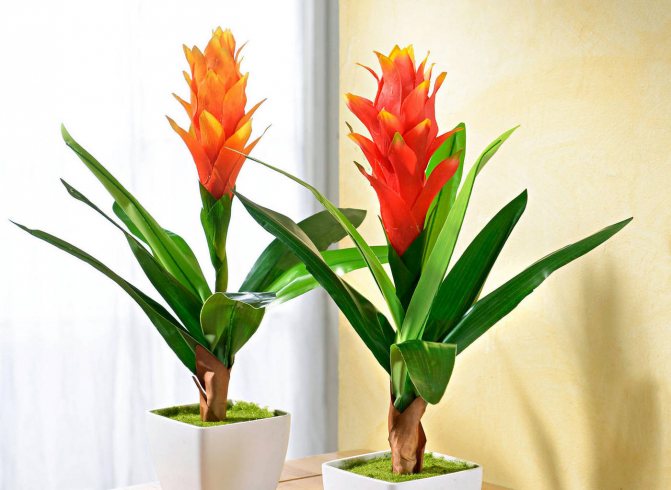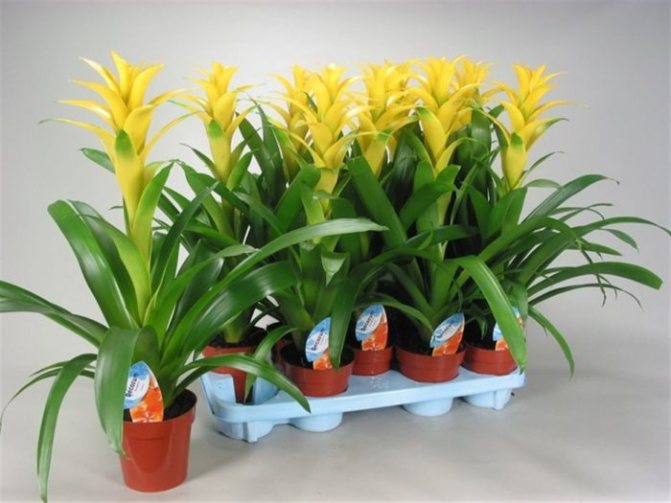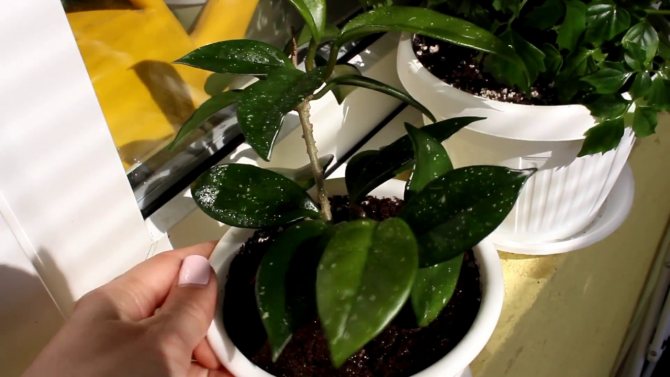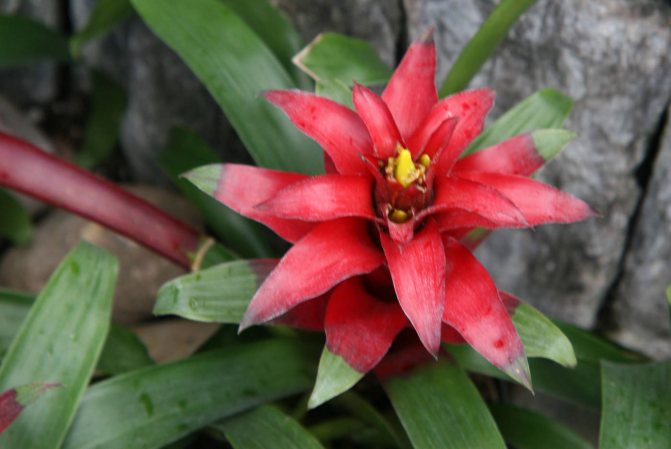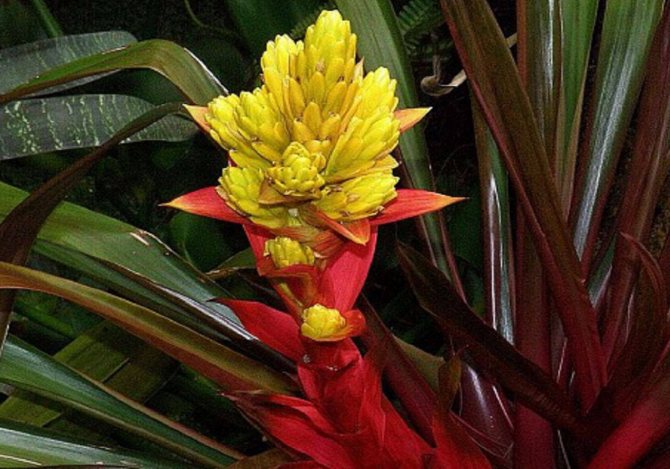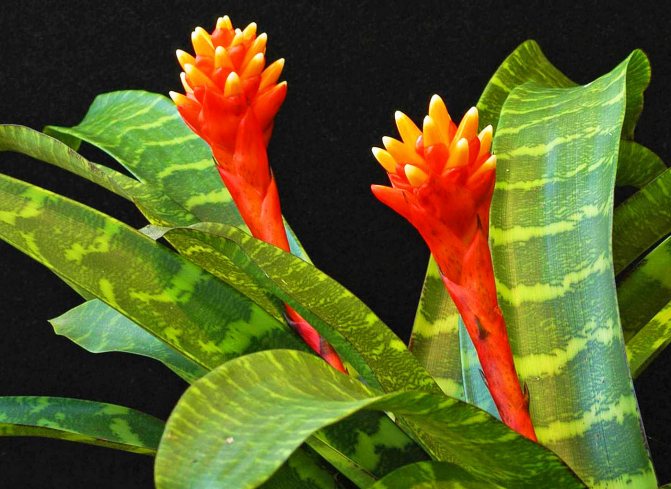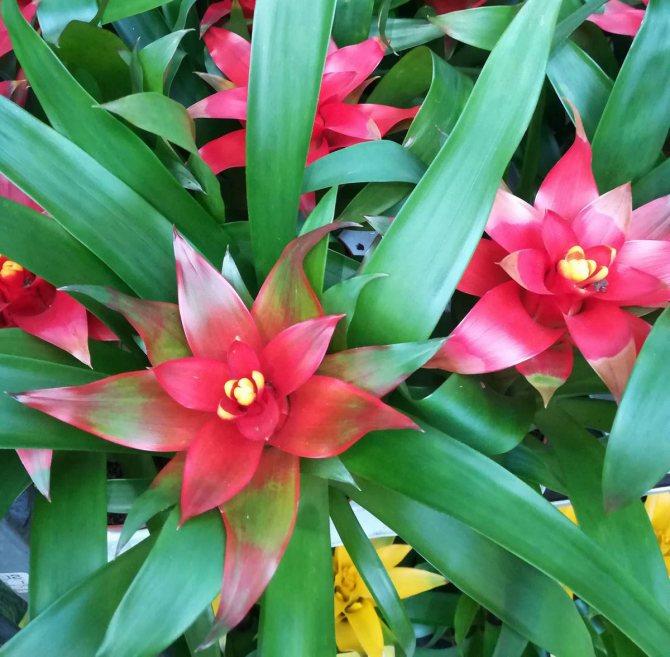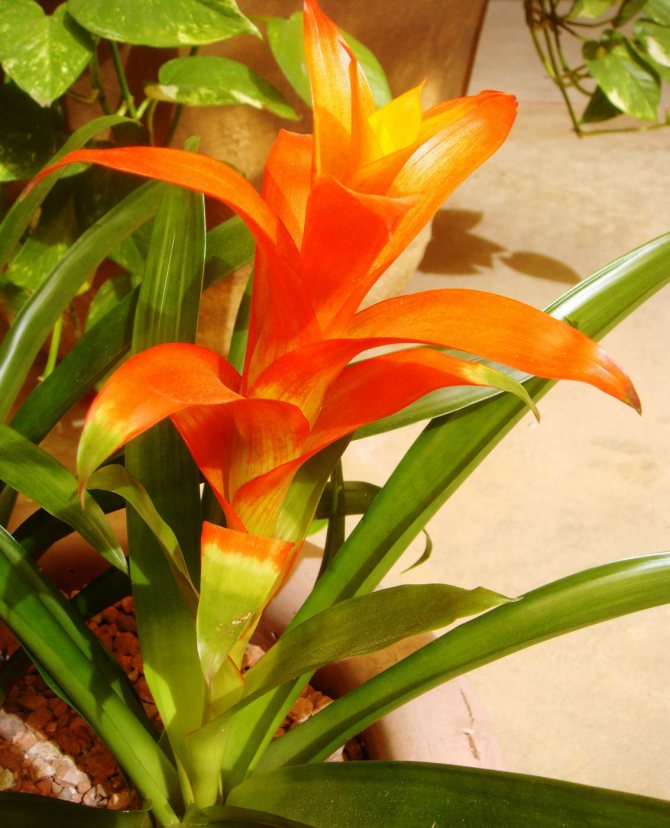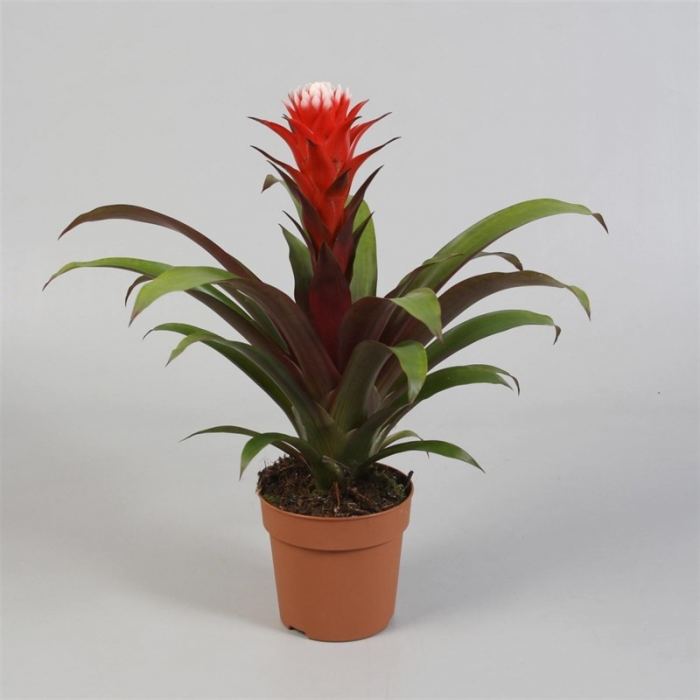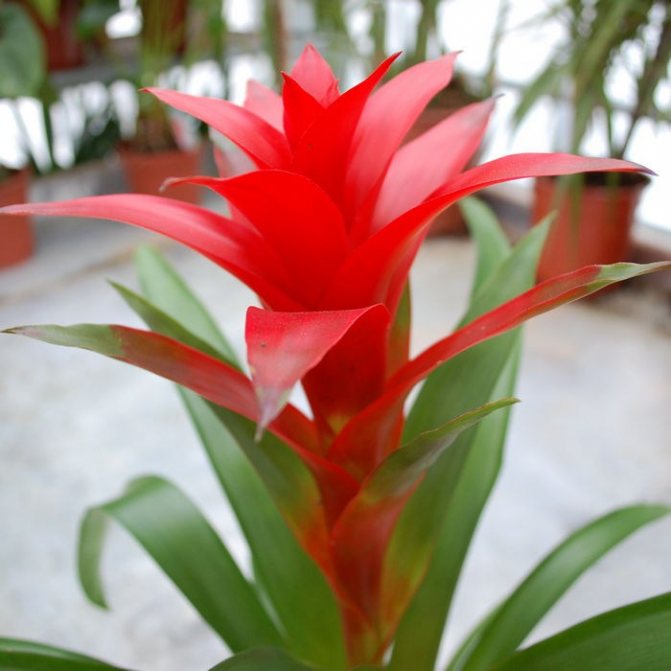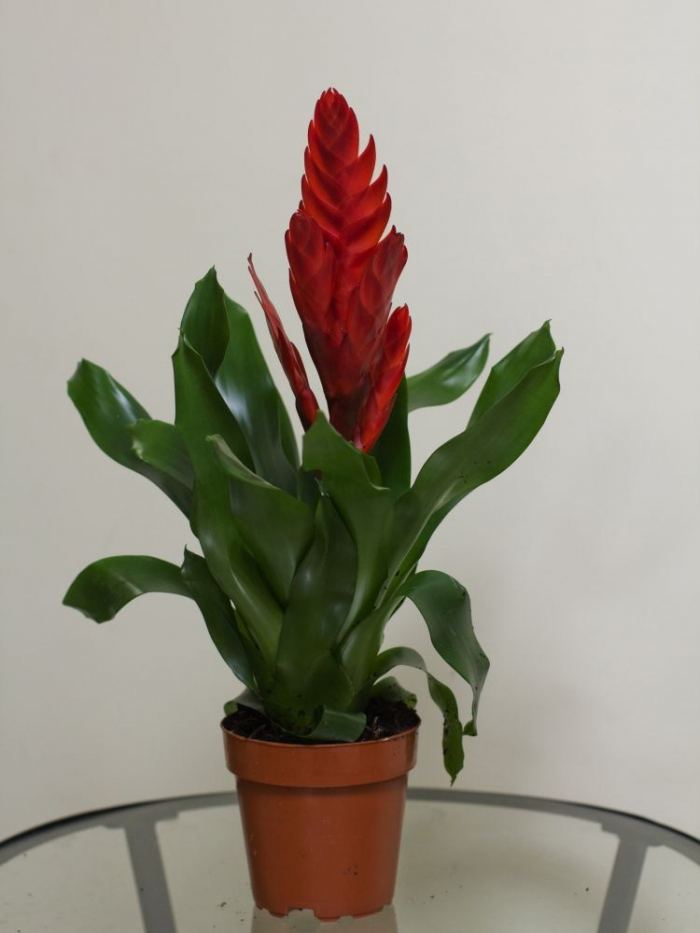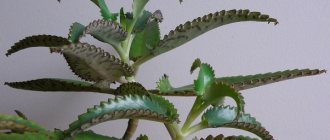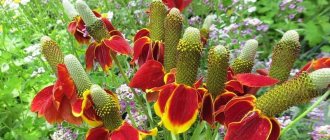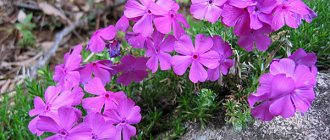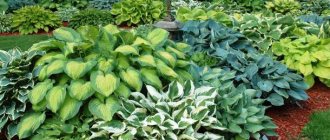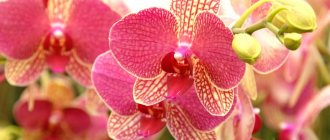Guzmania is a spectacular and bright plant, despite its not very sonorous "name". By the way, this indoor flower was named in honor of the discoverer of the Spaniard by the name of Guzman.
This 19th century biologist discovered an unusual flower in the American tropics, was fascinated by its flowering and decided to try to relocate the find closer to people.
Now the guzmania decorates not only summer gardens and famous flower gardens, but also home windowsills. And people who often plant such plants began to notice its positive effects on well-being and the atmosphere in the home. So, over the years of being close to a person, gusmania has already gained popularity and "overgrown" with signs and superstitions.
How to choose a plant?
You need to pay attention to the tips of the leaves so that they are not dried out, and the sensitive bracts and roots are not damaged.
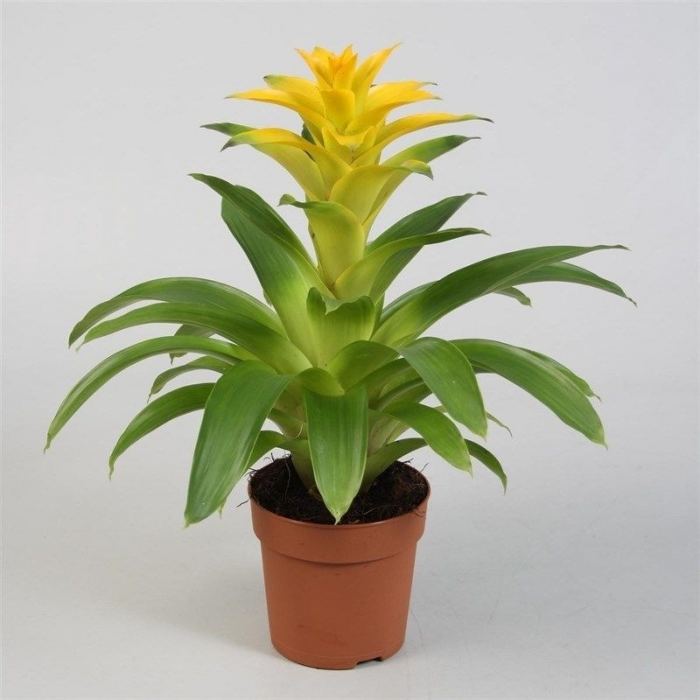
The tropical plant guzmania is unpretentious in care, and will become an ornament among other flowers.
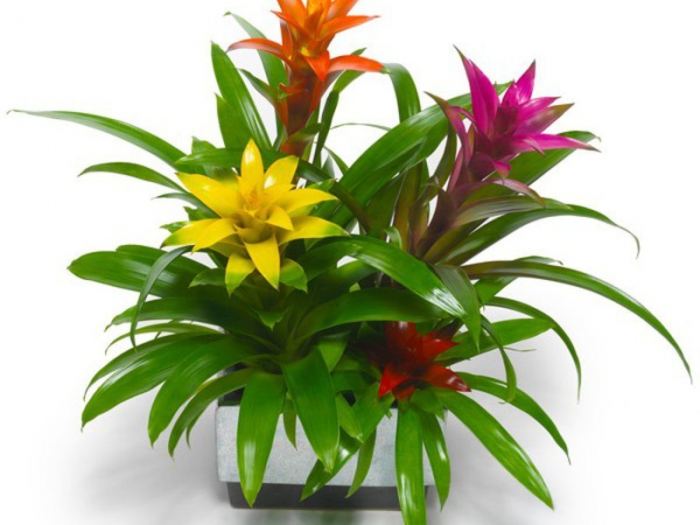

The height of a beautiful plant can reach up to 80 cm, taking into account the peduncle, it can reach a diameter of up to 25 cm. Wide long leaves grow in a circle in the shape of a funnel, from which a luxurious guzmania flower grows, like a cone.
Signs on the state of the flower
Guzmania is able to tell a lot or warn the owner - even without words. Everything will show the state of its leaves or flowers. According to signs, you can easily navigate and change something in your life.
Guzmania did not bloom in the fall, as expected, but at other times of the year. This is not quite a good omen - such a “flourishing” speaks of internal tension in the family. Perhaps one of the spouses started a relationship on the side.


The flowers have dried up. If the extravagant Guzmania flowers suddenly began to dry, it means that one of the household members is seriously ill. It is necessary to see specialists so as not to miss the ailment.
Green leaves turn yellowish. Such a sign suggests that someone from the family's environment has conceived something unkind. You need to be on the lookout and not trust even good friends or acquaintances.
The plant never bloomed. If you didn't manage to enjoy the lush flowering, you need to reconsider your behavior in life. This is a sign that it is time to change the attitude towards others, the environment around, and even change the field of activity.
Common varieties of guzmania
Guzmania red has leaves in the form of glasses, accumulating water in nature, leaves reach 30 cm in diameter.The plant blooms from April to August, purple (purple) inflorescences.


Mosaic Guzmania - especially spectacular because of the many pointed long leaves up to 70 cm. It blooms in June-September, the peduncle is white, yellow or pale pink.
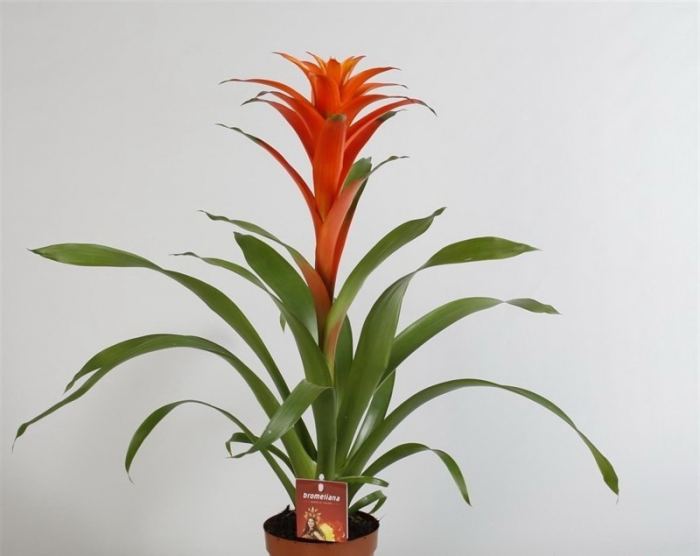

Guzmania reed is more accustomed to the apartments of amateur florists. A compact plant up to 20 cm with an elastic rosette of dark green leaves. The upper leaves are reddish, the flowers are yellowish or blue-white.
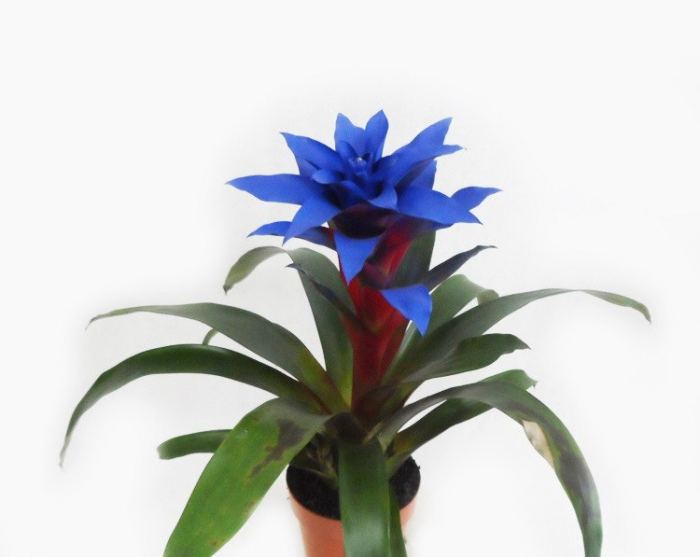

Botanical dossier
Guzmania is a herbaceous plant that develops in the form of a root rosette of hard, belt-like leaves, pointed to the top and arranged in a spiral.


The flower's root system is weak, like many epiphytes, adapted to life on trees and lacking the ability to absorb moisture and nutrients.
All this plant receives with the help of a funnel-shaped rosette, in which, in addition to precipitation, plant residues accumulate, wind-blown dust or parts of dead small insects settle.
Many species of guzmania are monocarpic plants, that is, after flowering, the mother's rosette gradually dies off, but leaves behind a whole garden of children.


Home guzmania blooms with proper care for the 3-5th year, but it can form a peduncle in the second year of life.
Very often, the dying off of an old outlet is perceived by inexperienced growers as an error in care, but for guzmania this is considered normal and inevitable.
The flowering process begins with the appearance of lightened leaves in the center of the rosette, transforming over time into bright stipules.
Later they acquire pink, orange, blood-red, yellowish color, there are varieties with white sultans.
A spike-shaped inflorescence rises above the rosette for several months.
Flowers are small and inconspicuous, in many species they do not open until pollination occurs inside the bud: they are characterized by the so-called phenomenon of cleistogamy - a type of self-pollination with closed corollas.
It is interesting!
If the guzmania does not bloom after 2-3 years with good care and a healthy look of the plant, it is "helped" - they cover it with a plastic bag and put a fresh apple or banana inside. As the fruits begin to deteriorate, they are changed until the leaves in the center of the rosette begin to acquire a colored shade - which means that a peduncle begins to form. The accessories are then removed.
Guzmania care
Having a guzmania flower in the house (apartment), it cleans the air from harmful substances (formaldehyde, etc.).
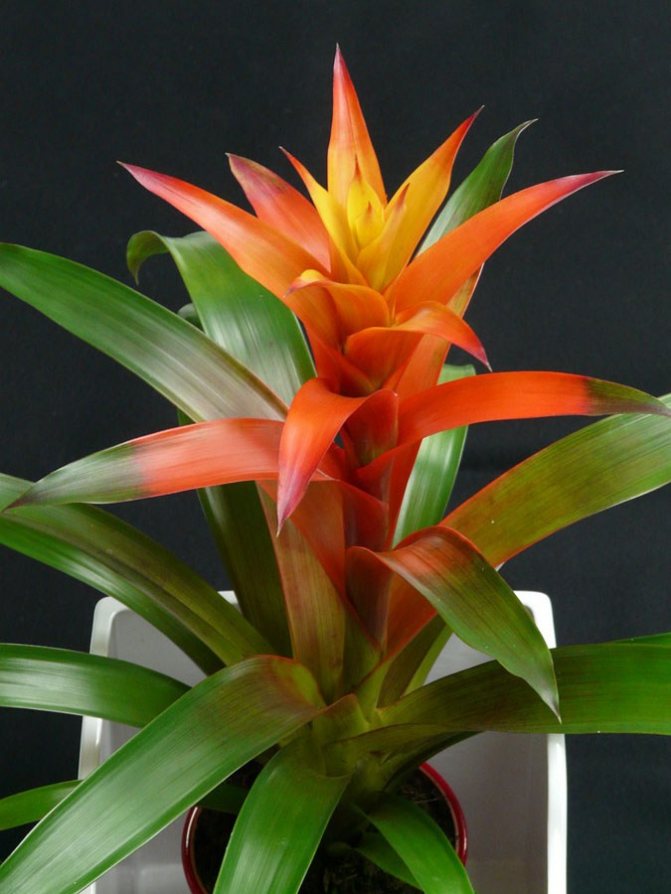

It does not require much attention, but it is better to adhere to some of the recommendations of experts:
- The plant is afraid of drafts and dustiness of the room.
- It can also suffer from sudden changes in temperature.
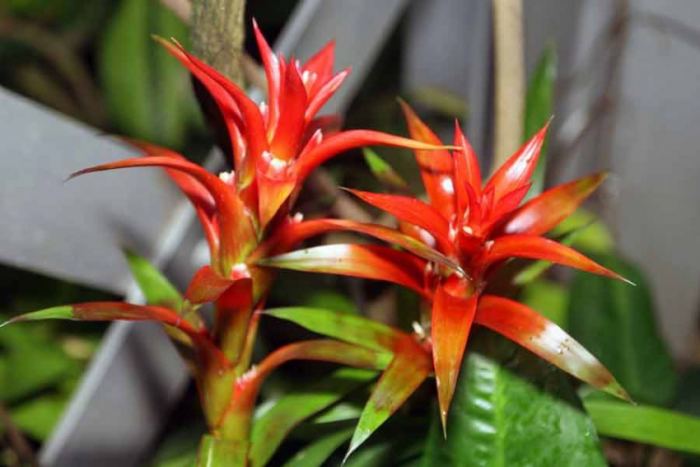

Signs and superstitions about guzmania
Bright red, light yellow, orange and scarlet flowers have won many hearts of flower growers. The unusual shape of the flower, like the top of a pineapple (by the way, in the world of plants it is a close relative of gusmania), its brightness and uniqueness charges with positive emotions for the whole day. And this is not the only sign that the guzmania was awarded.
In the homeland of the flower, it is believed that the plant gives strength to the male sex - not only physically and emotionally, but also in the love sphere. Therefore, it would be nice to have such a plant at home and put it, for example, in the bedroom.
Depression, stress and troubles take a lot of mental strength. It is believed that guzmania is able to relieve stress from the owners, gives a charge of positive emotions and brings them to their senses.


According to signs, guzmania helps to cope with insomnia and nightmares. Its energy acts exactly like a mild sedative.
Superstitions also suggest that gusmania may well compete in "effect" with the money tree: the plant brings prosperity to the house and improves the material situation of the owners.
Acting as an antidepressant and an assistant in absolutely all spheres of life, guzmania is able to establish harmony in the house, and to the owners to prolong life.
Temperature regime
Guzmania at home does not require much attention. In summer, up to +25 degrees, and in winter it transfers up to -15 degrees. You should not overcool the flower so that the plant does not hurt.
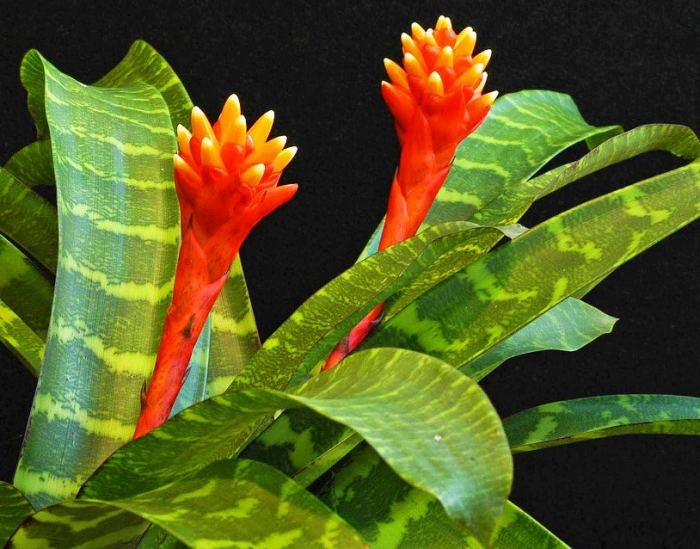

If the room is dry, then frequent spraying is necessary. The plant loves moisture, so it is better to place the pot with the plant on a pallet with wet expanded clay (sand), without touching the expanded clay itself.
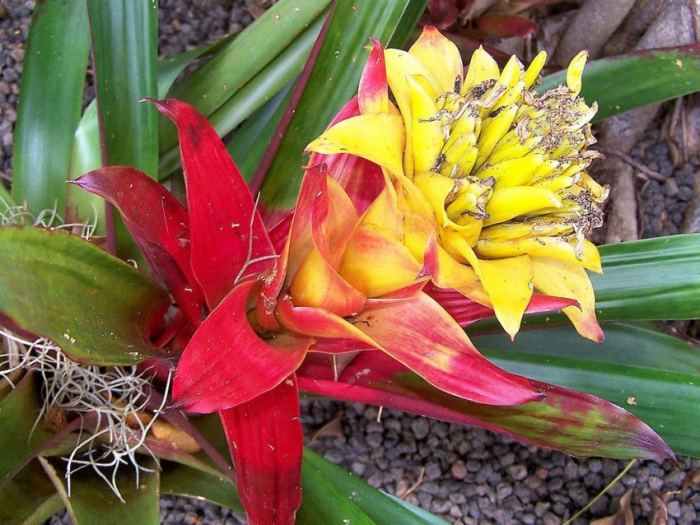

In winter, you should not overmoisten and supercool the beauty.Watering should be reduced and rarely watered when the soil is dry. For additional lighting, it is better to place a fluorescent lamp next to it.
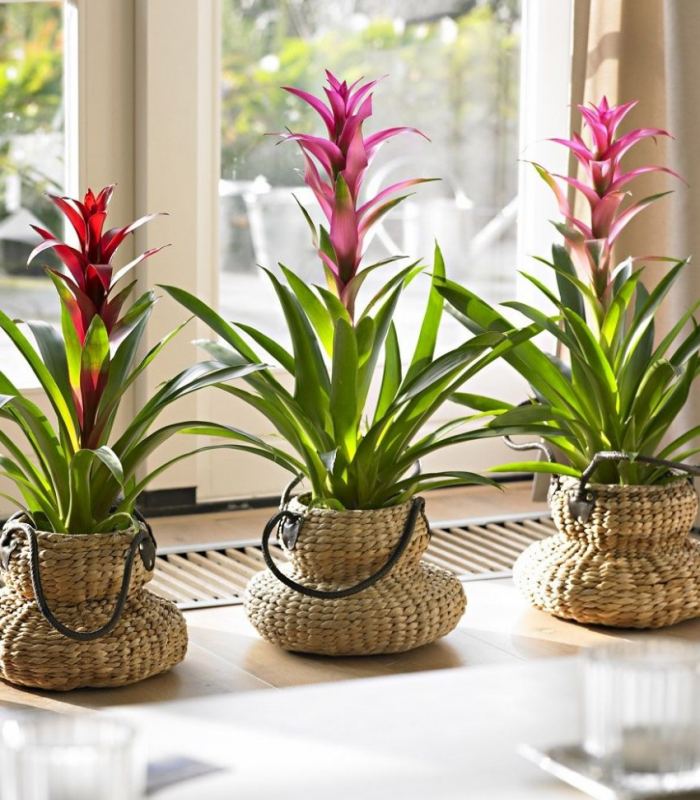

The technology of reproduction of guzmania by children
It is important to be able to determine the timing for the separation process of young plants. The breeding procedure can begin when, after the flowering period, the flower has dried up, and babies have appeared next to the main trunk.
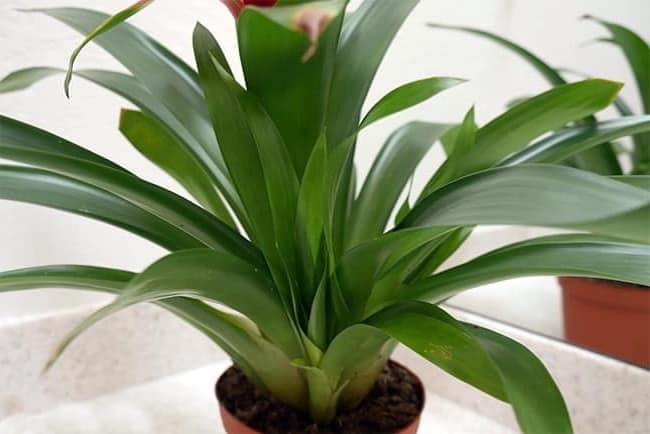

When to transplant babies
- Make sure the babies are two-thirds larger than the mother bush. Only at this time they already have a sufficiently developed root system.
- Many growers, when they see pale leaves after flowering, think that the plant is painful. But this is a natural process. Guzmania blooms 1 time, and then dies, but the children are the successors. They also need to be transplanted.
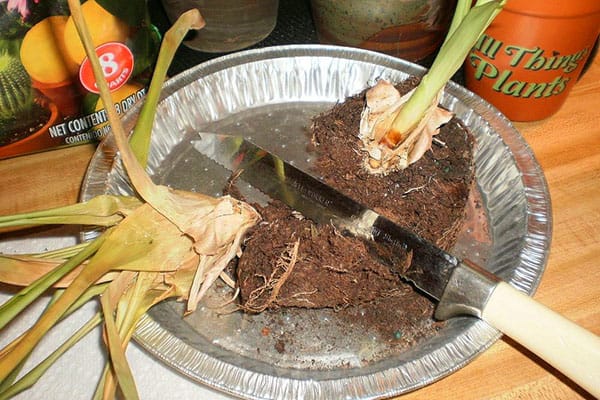

We build up the root system
The problem of the lack of full-fledged roots in children often raises concerns that the plants will not take root. Some growers wait for the mother part to dry completely.
If there are several new shoots, it is necessary to distribute them in different pots. To grow roots, cover the base with moss and keep the area constantly moist. Add a growth promoter to the water.
Transfer
Perform the procedure in the spring.


- Remove the plant from the pot.
- With a sharp, disinfected knife, separate the children with young roots.
- After transplanting the children in a container, they are poured with water with Kornevin and covered, creating greenhouse conditions.
- Within 14 days, growth stimulants are added to the water and the soil is moistened, the plant is sprayed.


When the children begin to grow actively, and the leaves do not wither, the greenhouse is removed. It is necessary to accustom to air gradually.
Fertilizing Guzmania
A universal fertilizer for flowering plants and bromeliads is suitable for feeding. It will be enough for all six months from May to September to breed and fertilize a couple of times a month, as indicated in the instructions.
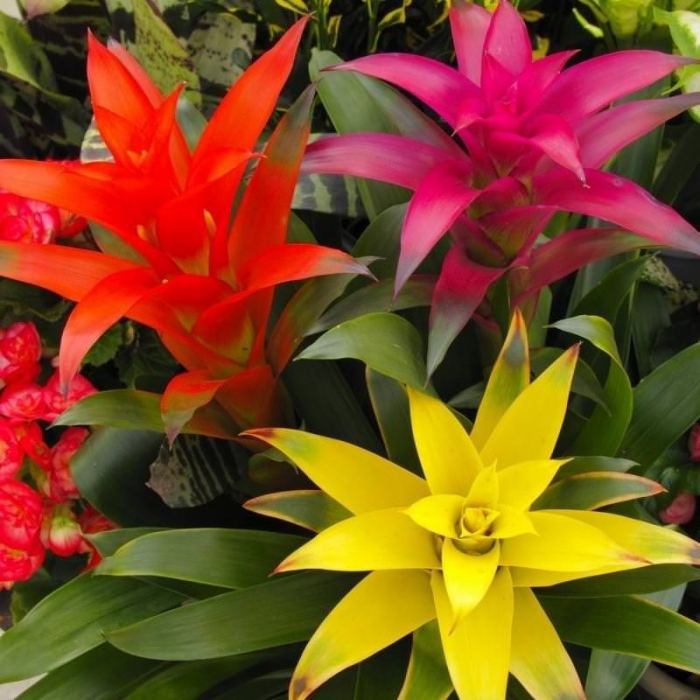

To prolong flowering, it is better to apply fertilizer 1 time in 10 days.
Difficulties in growing a guzmania plant
In the process of growing, you may encounter various difficulties associated with the peculiarities of the life of the guzmania and the intricacies of care.
How long does guzmania live
On average, the life expectancy of Guzmania is approximately 3-4 years. Moreover, before flowering, the plant lives from one to two years. Then the inflorescence appears and blooms for about 6 months. After the flower has faded, the maternal stem is able to live for up to 6 months, and then dies off, leaving daughter shoots. When buying a weft from the seller, how long does the guzmania bloom.
Why guzmania does not bloom
The lack of flowering is due to insufficient watering, limited light and low air temperature. Provide the plant with the necessary conditions, adjust the watering, put the pot in a brighter place and it will bloom.
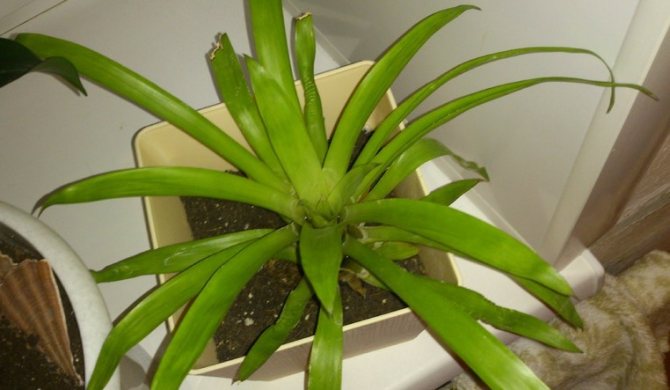

How to make guzmania bloom
It happens that a plant does not bloom for several years in a row. Experienced growers use a simple method to push the plant to bloom. It is known that decaying apples secrete a special substance - acithelen, which, in turn, is excellent for the development of tropical plants. Just place the rotten fruit along with the guzmania under a plastic bag and wait for it to bloom. During this period, do not forget to air the flower daily, and make sure that no mold appears on the surface.
Why do Guzmania leaf tips dry?
Dryness of the tips of the leaves most often causes too dry air. Move the pot away from heat sources and regularly spray the leaf plates with a spray bottle. Install a humidifier in a room that is too dry.
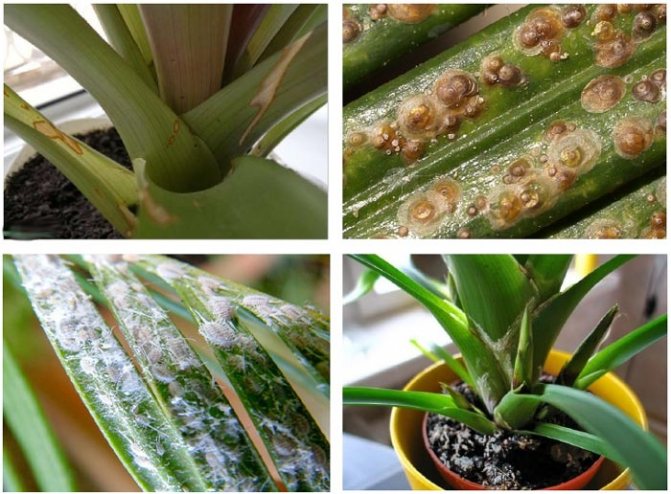

Why do Guzmania leaves turn yellow
If Guzmania has any health or developmental problems, it shows it with yellowed leaves.There may be several reasons for this phenomenon:
- growth has stopped, which means that the plant does not have enough nutrition or there is too little space in the container (sometimes the growth of guzmania stops just before flowering);
- roots rot, which means that irrigation norms are violated;
- scabbard infection;
- fungal infection.
With the resumption of the norms of care and timely treatment, the guzmania will return to normal life, and its leaves will turn green again.


Why does Guzmania not give children
You may have made a mistake and removed the mother stem too early. As a result, the root system of the plant did not grow sufficiently and could not sprout new shoots.
Guzmania is an amazing plant that will delight its owner with bright, long flowering. Unfortunately, the flower blooms only once in a lifetime and dies off. After flowering, the guzmania leaves young shoots that you can plant and grow new adult bushes. In order for an adult plant to bloom for a long time, and new shoots to begin and grow, it is enough to simply observe the necessary conditions for growing and transplanting.
Did you like the article? Was she helpful?
Guzmania transplant
The plant can be replanted every 3 years in the spring. Young shoots can be planted by separating them from the adult plant. For a young plant, a shallow but wide pot is suitable. Turf with peat 1: 1, add sphagnum, pieces of bark, perlite and charcoal. There is a special soil for the bromeliad family on sale, loose and soft.
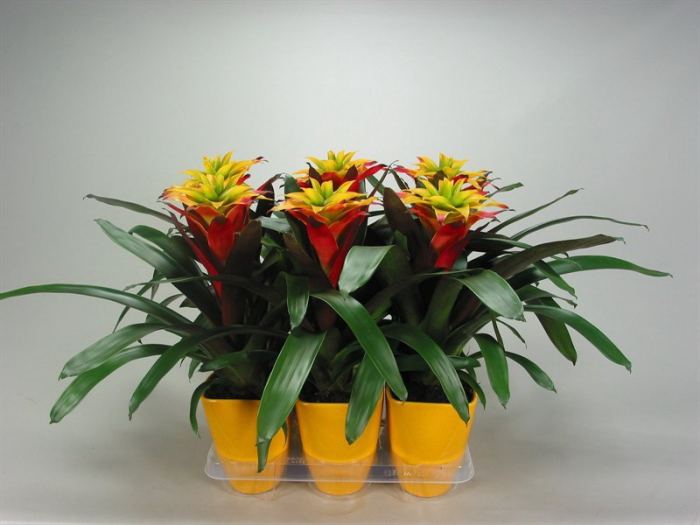

- Ktenanta - types, cultivation features and instructions for home care. 110 photos of plants
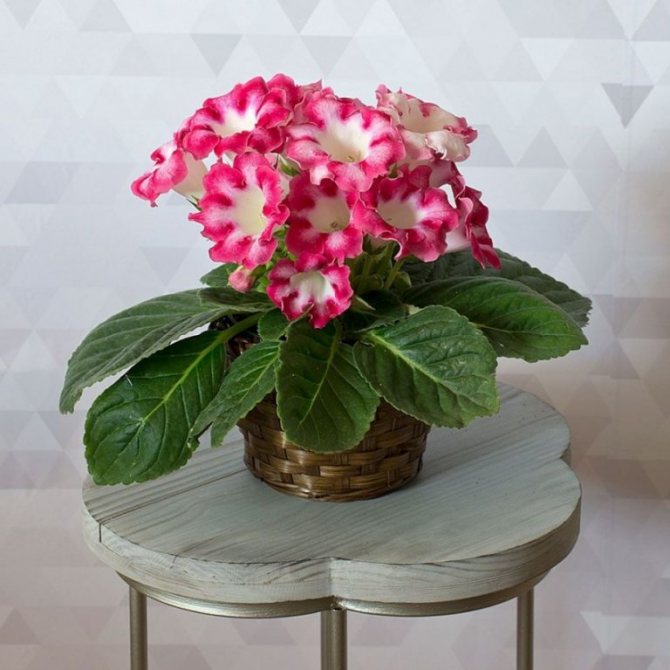

Gloxinia: growing and caring at home. 165 photos of a flower and the rules for planting it
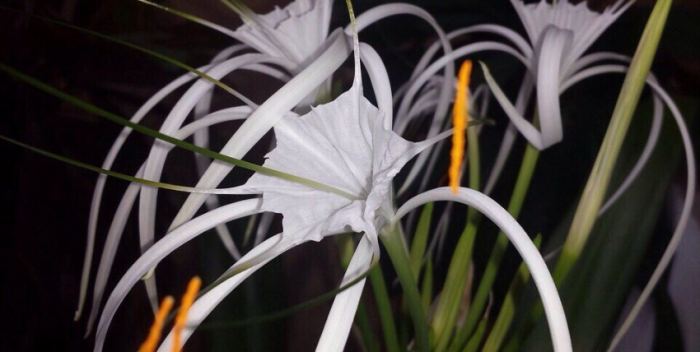

Hymenokallis: the choice of planting material, planting, maintenance, care, reproduction and advice on pest control (155 photos)
Important! The roots of the plant are very fragile, so special care and accuracy is required when transplanting.
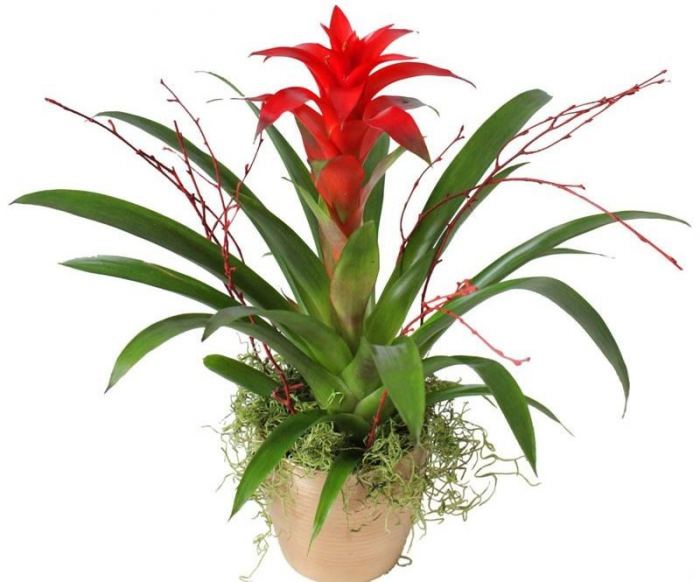

The plant does not need pruning.
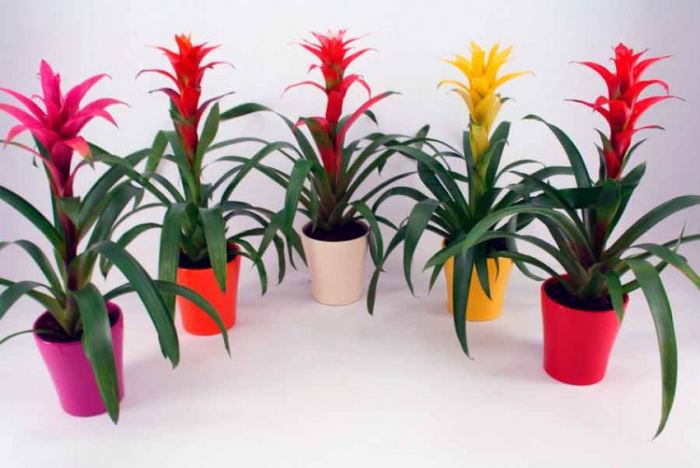

In addition to the lateral processes ("children"), the plant is propagated by seeds. They will appear after long flowering. The color of the flowers is amazing: from yellow to red and even purple.
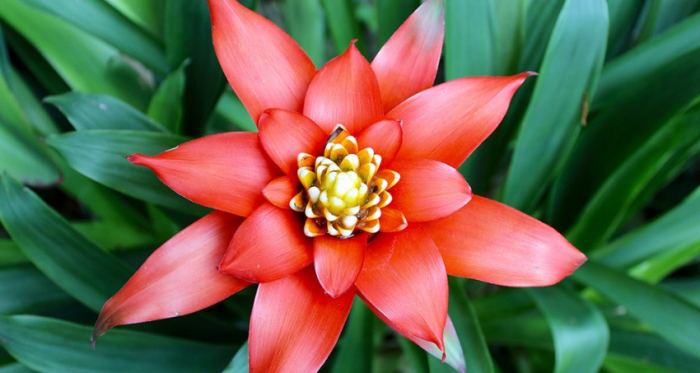

When the adult plant has faded, you need to cut off the peduncle so that the shoots appear. After that, the "mother" plant ends its life cycle.
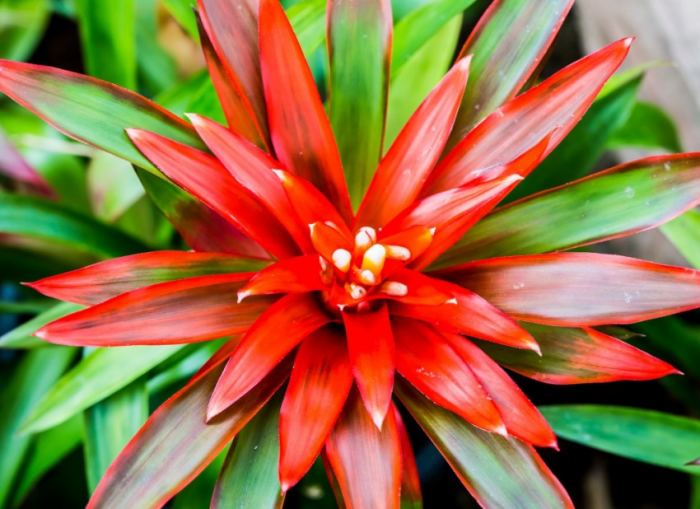

general characteristics
When you see guzmania for the first time, it is absolutely impossible to guess that the plant belongs to epiphytes and in natural conditions grows on the bark of old tropical trees.
Brief botanical description


- The homeland is the southern part and center of America. Sitting on tree trunks, the plant receives the required amount of moisture from the air. Therefore, it is necessary to maintain the desired level of humidity in the room.
- There are about 100 species of Guzmania in the world, but only a few are often grown indoors: Reed and Minor Rondo.
- Many consider the flower to be very capricious and whimsical. But this opinion is not entirely true. Subject to all agrotechnical rules, guzmania can be successfully grown and propagated.
- The most vulnerable is the root part of the plant. After flowering, the flower dies, so you need to quickly transplant it.
- In the wild, the height of the bush reaches 70 - 80 cm. In the room, usually the guzmania does not grow more than 40 cm. It lacks light, moisture, and the root system of the area for development in a pot.
- The plant is most decorative when it blooms: against the background of lush green foliage, we can see red, dark pink, burgundy falling petals.
Interesting: Guzmania is good to grow indoors, since its huge advantage is its ability to absorb dust and purify the air.
Transplant after purchase
As soon as the plant has appeared in the house, it must be identified as quickly as possible in a new flowerpot and given a new place of residence.
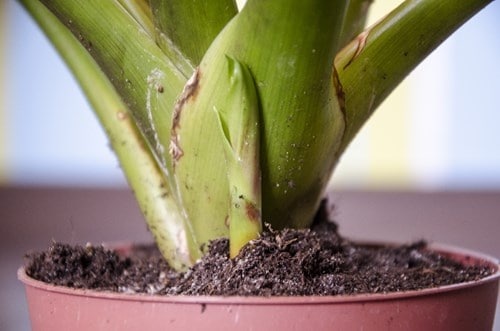

Soil composition
Not any soil can be used for the process of transplanting guzmania. The substrate must conduct moisture and air very well, be light and loose. You can recommend the following composition:
- 1 piece of turf;
- 1 part sand;
- a pinch of charcoal;
- 1 part peat in the form of fibers.
There is such an option:
- 1 share of sphagnum moss;
- 3 lobes of coniferous bark (fern roots can be used);
If there is no experience in growing such plants yet, then purchase a ready-made substrate for orchids or bromeliads. It is also suitable for cultivating guzmania.
Pot selection and planting
You should not purchase a pot that is too deep, as it will be difficult to care for the root system. Choose a shallow pot, no more than 10 - 12 cm in diameter.
Note that the drainage layer fills at least two thirds of the container. When transplanting, experienced florists recommend using the transshipment method. The root system is very delicate and fragile, so it must be handled with great care.
Important: the root collar cannot be buried. It is strongly not recommended to tamp the substrate, as is the case with other indoor plants. You just need to tap a little on the walls of the pot so that the parts of the soil fit more tightly.
Possible diseases
If the plant is flooded, this can be the cause of the appearance of fungi, possibly rotting of the roots. You need to immediately stop watering, and gradually add water to the outlet of long leaves.


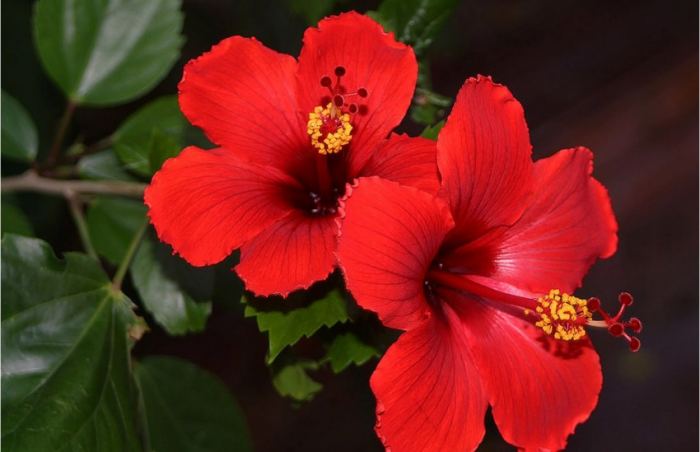

Hibiscus: overview of species, rules of care, breeding problems and description of options for growing at home (145 photos + video)- Vriezia: rules for the care and cultivation of an indoor flower. Features of planting and reproduction of Vriezia (125 photos)


Bougainvillea: proper cultivation and expert advice on breeding at home (135 photos)
The plant is susceptible to spider mites and mealybugs. To save the plant, you need to treat damaged leaves with soapy water. You can also spray the beauty with a special remedy for various pests.


When white bloom appears - a consequence of hard water or spraying, you can use rainwater or purified water.


Luxurious guzmania is a decoration of any apartment (house). Knowing the features of watering and how to transplant guzmania, you can enjoy the beauty of an exotic plant for many years. Some people will like the yellow flower, others - purple or rose-red.


Below in the photo of guzmania of different varieties and shades of the peduncle.
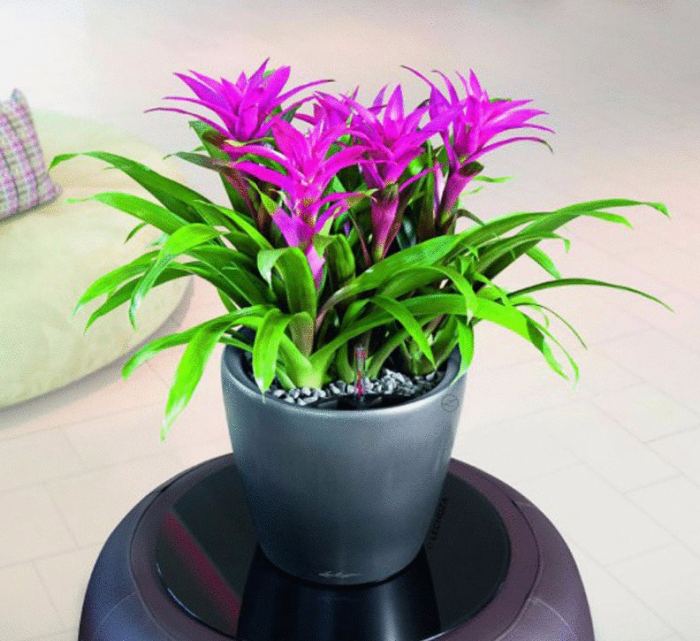

Diseases, pests and methods of dealing with them
The result of improper and untimely care of plants are diseases and the appearance of pests on guzmania.
To prevent fungus or roots from rotting, do not overfill the flower. If you notice signs of decay, such as wilting of leaf blades or spots on them, immediately revive the plant. This can be done with the help of fungicide preparations (Rovral, Oxyhom, Fundazol), dissolving them in water according to the instructions on the package.
Also, guzmania can be damaged by aphids, scale insects, spider mites or mealybugs. Insects feed on the sap of the plant, which significantly slows down its growth. Use special insecticides to control pests.
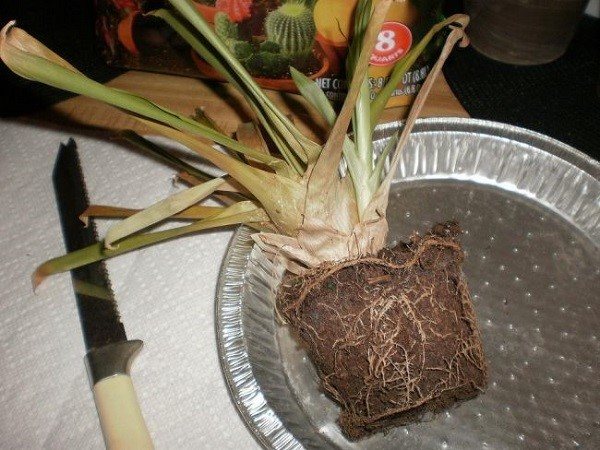

What guzmania brings to the house
Many growers are sure that the benefits of this tropical plant are enormous. But there are also skeptics who find not very good features in the action of a flower. Fortunately, there are not many of them. So what does the guzmania flower bring to the house?
- Cleans the air, disinfects. The substances that gusmania secretes during flowering have bactericidal properties that rid the surrounding space of microbes, including pathogens.
- It gives aesthetic pleasure, although guzmania blooms only once in its life, but all autumn and until spring.
- Brings harmony to the family, creates a positive aura at home.
- Activates masculine strength.
- Develops creativity, gives inspiration to household members.
- Attracts financial well-being.
- According to legends, in people who are greedy and evil, the positive properties of a flower do not work in full force or are completely lost. It happens that all the shortcomings of the owners are doubled.
- According to signs, guzmania can attract intruders to the house.
- If the plant does not like the aura of the dwelling, gusmania can affect the household in such a way that they think about moving or decide to make a rearrangement with a change in the interior.
- Allergy sufferers during the flowering of gusmania may experience exacerbations, malaise and drowsiness.
Flowering and dormant periods
The most important and difficult period in the life of a plant is the time of flowering. The first bracts in Guzmania appear only in the third or fourth year of development. Flowering continues for several months, but only in favorable conditions. As soon as the shade of the foliage of the guzmania changes or a green peduncle slowly begins to rise from the outlet, this is the very moment before flowering.
The plant does not have a pronounced dormant period. The flower does not shed its leaves, the lighting requirements do not change. He only needs to lower the temperature of the content, reduce watering and stop feeding.
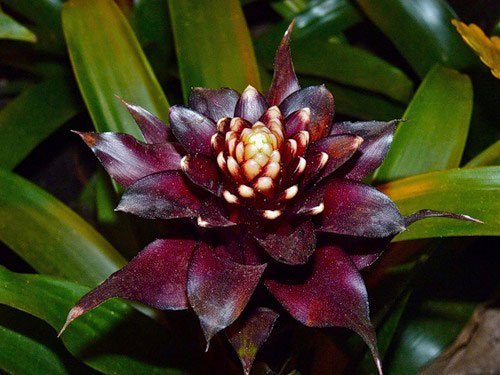

The flowering of guzmania is a clear sign that the flower is completely satisfied with the conditions of maintenance and care provided by the florist
How to make guzmania bloom?
There is a trick that allows you to bring the moment of blooming guzmania closer. To do this, place a container with chopped apples, pears or bananas next to it and cover the entire "composition" with a plastic bag. During the decomposition of the fruit, ethylene is released, which stimulates flowering. You just need to be careful not to allow the appearance of mold, which can provoke the development of rot.
Common care mistakes
Direct sunlight in summer is detrimental to many plants, including Guzmania. She can easily get burned if you keep her on the south window all day without shading.
If the air around the plant is too dry, especially in winter, when the heating devices are working, the tips of the leaves turn brown, curl and dry. It is necessary to constantly spray the flower and the surrounding air from a spray bottle.
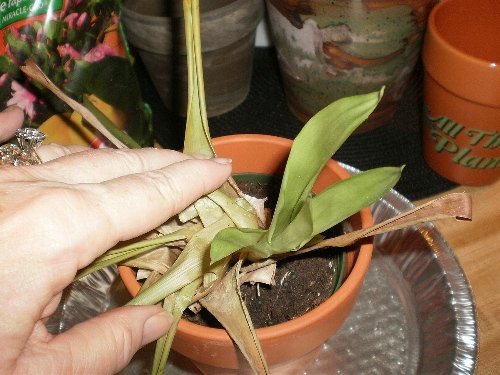

Direct sunlight and dry air are detrimental to guzmania
Guzmania grows in those areas where the water hardness is very low, and the flower reacts sharply negatively to what flows from the water supply system, an ugly white coating appears on the leaves. It is important to defend the water by adding calcium, chlorine and fluoride compounds, apple cider vinegar or citric acid to neutralize it, pass it through a filter or boil it.
When the substrate for guzmania is chosen incorrectly, bays are the most common cause of flower discomfort.


Due to excessive watering, rot quickly develops; most often the plant affected by it can only be thrown away
Novice flower growers mistakenly assume that a tropical epiphyte will thrive in ordinary flower soil. As a result, the roots of the Guzmania cease to breathe in a stuck together wet earthen coma and rot.
Table: why leaves dry, curl, turn yellow and how to fix the situation?
| Common mistakes | Consequence of errors | How to avoid the problem? |
| Sunburn | Light spots on the leaves, which then dry and die off. | Shading from direct sunlight or finding a more suitable place for the plant. |
| Dry air | Brown and dry leaf tips. | Regular spraying of the flower in winter, increasing humidity in other available ways. |
| Hard water | White bloom on the leaves. | Deposition of tap water, its filtration or boiling. Ideally, rain or melt water should be used for watering. |
| Excess watering | Drying of the leaf, dark spots, completely rotted root collar. | If the root collar has rotted, the flower can only be thrown away.In the earlier stages of the development of rot, an urgent transplant into a new pot with a complete replacement of the soil and pruning of all even minimally affected tissues can help. |
Video: how to save guzmania, affected by abundant watering
When to transplant?
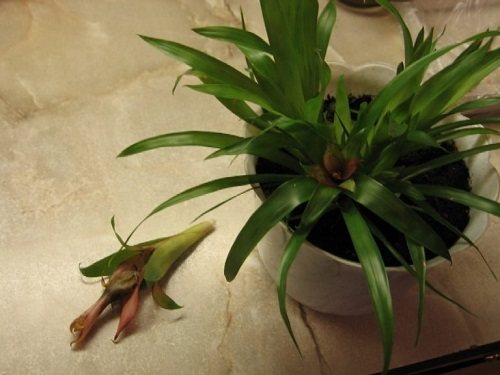

Guzmania babies will not be ready for separation before they have formed their own root system. As soon as the peduncle on the mother plant begins to fade, it should be cut off so that the flower does not waste power in vain, but directs it to the active development of children.
At the same time, it is necessary to stop watering the guzmania into the outlet, otherwise the plant will rot.
The transplant of Guzmania children must be done in the spring. If young shoots have appeared in the autumn-winter period, it is better to postpone the procedure until March.
How to transplant guzmania after purchase
Like any plant, it is advisable to transplant guzmania after purchase. Many amateur flower growers try to transplant any kind of guzmania for the first and only time immediately after purchase. As a rule, already blooming guzmania are sold by florist companies and shops, so after about six months the apical part of the plant will dry out and the flower will die.
In order to obtain long-lasting and abundant flowering, as well as high-quality planting material in the form of children, it is necessary to carefully remove the plant from the transport soil and transplant it into a new planting container filled with a nutritious soil substrate. It is best to transplant the acquired ornamental crop into purchased nutrient soil for growing bromeliads. You can prepare a nutrient mixture yourself by mixing equal parts of turf soil, coarse sand, crushed sphagnum moss and peat chips.


Types of home guzmania with photos and names
Guzmania lingulata (Guzmania lingulata)
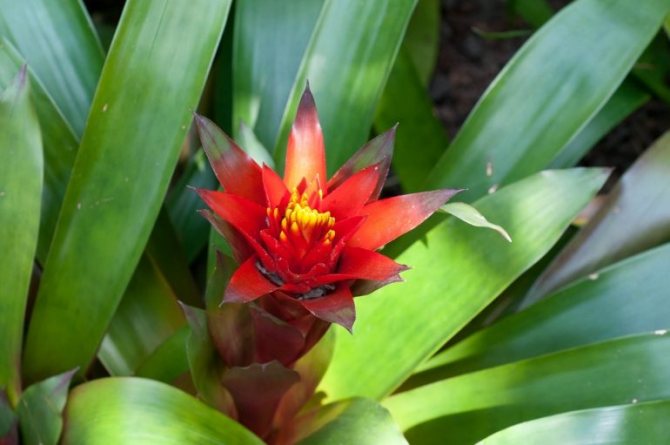

Forms a dense dense rosette of broad-linear pointed leaves with a solid edge. The color of the leaf plate is bright green, shiny. Leaf length - 30-45 cm, width - 3-4 cm. The multi-flowered inflorescence is located on a short, thick peduncle. Bracts are red. The flowering period is winter - spring.
Prepare the pot and soil before planting.
We select the dishes for the new plant of a small size and volume, since the roots of the guzmania are superficial, then the pot should not be deep. The optimum height of the container is no more than 12 cm. In a large container, a young plant may die due to stagnant water.
If the pot is not new and remains from another plant, then wash it thoroughly with soapy water, be sure to rinse it several times with boiling water. This is necessary so that the young guzmania does not become infected with the fungus.
As a soil for transplanting guzmania, a purchased substrate for bromeliads is suitable. It consists of sand, clay soil, sphagnum, charcoal and peat. You can add a little wood bark, coal to the soil mixture. Expanded clay, broken brick, glass are used as drainage material.
Watering and humidity
During after landing Guzmania seedlings need high indoor humidity. Therefore, it is better to immediately place the pot in a pan with water so that the bottom of the pot is above the water level. If this is not possible, use a known method.
Fill the pallet with pebbles, expanded clay or crushed stone and moisten it, but so that water does not protrude to the surface.
Upper layer the soil in the pot should dry out between waterings - this will give the roots of the Guzmania a chance to "breathe". And spraying with boiled or well-settled water at room temperature can be brought up to several times a day - this will not harm the seedlings.
Process rooting young guzmania is quite long - from one month or more.
After the appearance roots young specimens must be transplanted into fresh soil. And then you have a rather long waiting period for flowering: 2-3 years, in some cases up to 5 years.
Growing Guzmania at home from seeds
Before planting guzmania, its seeds are soaked in a weak solution of potassium permanganate, then dried and planted in soil consisting of peat and sand. They are evenly distributed over the surface of the seedling box. They should not be buried or covered with soil, since germination takes place only in light.
The plantings need to be covered with glass, which is regularly removed for ventilation and spraying of crops. The container should be located in a room with an air temperature not lower than 25 degrees... With good seed quality and proper maintenance, the first shoots should be expected after three weeks.
After two months, you can pick the seedlings into small pots (no more than 7 centimeters in diameter) with the soil used for transplanting the shoots.
Insects are pests


Sometimes Guzmania attracts various sucking insects such as spider mites, mealybugs, and scale insects. They are easy to recognize by the spoiled (sticky bloom, thin cobwebs and various secretions), leaves of the plant. It is advisable to wipe the leaves with a cotton swab moistened with a solution of laundry soap. The shield can be assembled by hand. And then still sprinkle the flower with some suitable insecticide, such as Aktara, Aktellik or Fitoverma. Check with the store and follow the instructions. Observe the multiplicity and number of treatments, too, in order to be guaranteed to get rid of all individuals.
Possible problems
In the process of cultivating guzmania, a florist may encounter a number of problems:
- Decay of roots. The reason for the decay of the root system of a plant is abundant watering, so irrigation of the crop must be dosed.
- Fungal diseases. If the plant is kept in a very warm and humid room, then the risk of fungal diseases increases.
- Brown and yellow spots on the leaves. Brown spots on the leaf plates indicate sunburn, and if the tips of the leaves turn brown, then the air contains little moisture.
- Discoloration of the tips of the leaves. Changes in the color of the tips of the leaves can be triggered by watering with hard water or a lack of water in the outlet. If yellow spots have formed on parts of the plant, it means that the flower is attacked by a red spider mite. In this case, if urgent measures are not taken to save the plant, the leaves will gradually turn completely yellow and die.
- The formation of chestnut outgrowths on the leaves tells the grower about the defeat of the bromeliad scabbard.
- White bloom on leaf plates. The formation of a white bloom, similar to cotton wool, indicates the vital activity of mealybugs.
- Soft leaves. Leaning down, flabby leaves indicate a low temperature in the room in which the guzmania lives.
- Burns. The appearance of burns on parts of the plant depends on exposure to direct sunlight, so the flower is placed only under diffused sultry rays.
- Lack of flowering. It happens that the flowering of an exotic beauty for some reason does not come. In this case, there is a way of stimulation: you need to put a couple of very ripe apples and bananas next to the pot, seal them all together with plastic wrap for a day. Then take off the shelter for a couple of hours and wrap it up with foil again. Continue this procedure for several days. When ripe, the fruits emit ethylene gas, which promotes flowering, so the result will not be long in coming.
How to transplant guzmania (video)
In some cases, the parent plant does not die after the formation of the offshoot, but develops further and forms new processes. As a rule, after flowering, the indoor guzmania withers and the peduncle must be removed, which allows not only to form, but also to grow up children. To stimulate growth processes, it is advisable to install a houseplant in shading and stop irrigation activities.... Most often, under such conditions, the process of forming a full-fledged appendix takes about three months. It is strictly forbidden to carry out the separation and transplantation of children who have not formed a root system.
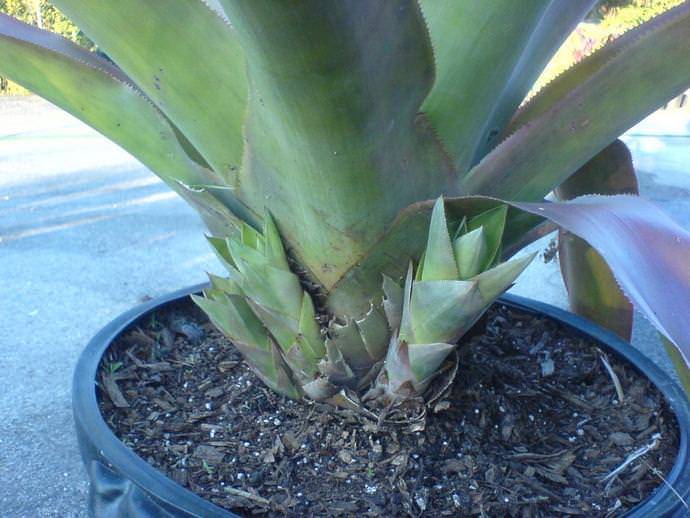

It is advisable to transplant babies to a permanent place in separate flower pots in spring., which will allow the young plant to adapt to the new growing site as soon as possible. You can also grow guzmania with seeds, which need to be disinfected in a pink solution of potassium permanganate, dry a little to a loose state and sow on the surface of a previously prepared soil substrate.
